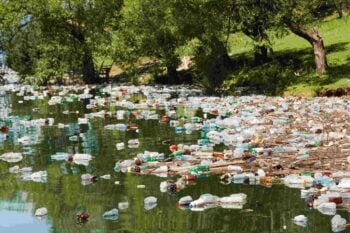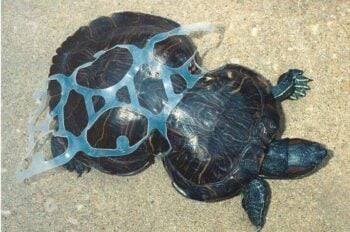It is very possible to get most of the plastic out of your life—especially the disposable and single-use plastic. (Though durable goods like computers and car parts will be the exception). Start with the low hanging fruit first, like buying your eggs in cardboard instead of polystyrene. Then consider taking on just one or two of the bigger changes a month.
Here are some suggestions for reducing both your use of plastic and your exposure to its toxins:
Reduce the Plastic in Your Life
We all need to decrease our reliance on plastic to lessen its impact on our health and the environment as much as possible. Here are some great ways to get started.
Out and About
- When shopping, use reusable produce bags to hold your produce, and reusable grocery bags to carry all your items home. Here’s an easy way to always remember them. You can also use reusable cotton sacks for bulk items like coffee, rice and nuts.
- Use reusable baggies instead of disposable plastic baggies for lunches and snacks.
- Use reusable glass or stainless steel water bottles to carry water with you.
- Bring your own containers to the restaurant for both carryout and leftovers. I use these containers, and as long as I hand them over at the same time I order my takeout, no one has turned me down yet.)
- Bring your own stainless steel coffee thermos to the coffee shop or office with you. Most coffee shops have no problem putting your latté in a reusable thermos.
- Ask for your newspaper and dry cleaning without plastic wrap.
- Don’t take the receipt at the register, or have the cashier drop it into the bag, then only handle it using gloves. Those slick, thermal-paper cash register receipts are a major source of BPA contamination via your skin.
Recommended in This Section
Pantry and Refrigerator
- Since plastic is found widely in processed food packaging (this includes canned foods and beverages, which have a plastic lining), the biggest thing you can do to reduce plastic toxins in your life is to shift your diet to include primarily fresh, whole, unpackaged foods from the grocery, farmer’s market or food co-op. Buying in bulk or joining a buying club can make this very affordable.
- Get your fresh eggs in cardboard cartons, not polystyrene. Get your fresh meat and cheese wrapped in waxed butcher paper, instead of plastic and foam.
- Get your fresh milk in bottles, not plastic-coated cartons or jugs. Many stores and farmers encourage you to return the empty bottle in exchange for savings on your next full one.
- Use old-fashioned, waxed butcher paper when you buy and store meats and cheeses. Use reusable freezer bags to hold freezer items that can’t go into glass or butcher paper.
- Avoid canned foods and beverages, including canned baby formulas. You can get many canned food items, like crushed tomatoes or broth, in glass jars or tetrapaks instead. If you can’t find other packaging, a few companies are offering their products in BPA-free cans, and the number continues to grow due to public demand. Here’s a list.
Kitchen
- Get a good water filter for your tap to replace bottled water. Or, if nothing else, buy bottled water only in reusable 5-gallon polycarbonate containers, and keep them in a cool, dark place. (Here’s how to find one.)
- Skip the straw with your drink, or use a washable, reusable straw instead.
- Store, reheat or freeze your leftovers in glass containers instead of in plastic “tupperware” or plastic wrap. (These are the containers we use, and while not 100% plastic-free, we love them.)
- Avoid disposable plastic or polystyrene dishes and utensils. Instead, go to the thrift store and get a stack of super cheap mismatched ceramic dishes and stainless steel cutlery that you use only for parties, picnics and the like.
- Replace your plastic kitchenware with items made from stainless steel, glass, ceramic, or even silicone instead.
- Make your own cleaners from non-toxic ingredients, and store them in glass jars and bottles. You can even take the spray pump off of an old spray bottle, and screw it onto a recycled glass vinegar bottle.
Recommended in This Section
Personal Care
- Make your own shampoo, lotions, liquid soaps, and cosmetics and store them in glass, ceramic or stainless steel containers. There are tons of DIY recipes on the internet you can make to replace all the plastic bottles of personal care potions you currently use.
- Replace your toothbrush with a non-toxic one. There are eco-friendly toothbrushes out there. Avoid plastic toothpaste tubes (and nasty chemicals too) by making your own toothpaste.
- Always ask for BPA-free dental sealants and BPA-free composite fillings at the dentist office. If your dentist doesn’t offer it, find one that does.
Kids
- Use cloth diapers.
- Because children are extra susceptible to the toxins in plastics, choose glass bottles with real rubber nipples, wood or cloth teethers, etc.
- Choose wood, cloth, steel and paper-based toys for your children over plastic, whenever possible. This is especially important while your kids are still young enough to put things in their mouths. See if you can get plastic toys like Legos second hand from eBay, Craigslist or other online outlets.
- Replace your school-age child’s plastic lunchbox with a cloth or stainless steel one. There are many non-toxic lunchbox choices, and most are great for adults, too!
Recommended in This Section
Related:
- What Do The Numbers on Plastic Containers Mean?
- Why You Should Finally Give Up Bottled Water for Good
- Why You REALLY Need a Water Filter (And How to Choose the Right One)
How Plastic Harms the Environment

Plastics are not only an issue for our health, but also for the health of plants and animals everywhere, which is why it is so important to reduce the amount of plastic in your life.
In spite of nationwide recycling efforts, we currently recycle only a measly five percent of the plastics we produce. And more and more cities are shutting down their plastic recycling programs because they are not cost effective!
Approximately 50 percent of our plastic waste goes to landfills (where it will sit for thousands of years due to limited oxygen and lack of microorganisms to break it down). The remaining 45 percent ends up as litter in the environment where it ultimately washes out to sea, damaging marine ecosystems and entering the food chain.
How Plastic Pollutes the Ocean

With at least eight million metric tons of plastic entering the world’s oceans every year, there is growing concern about the overwhelming proliferation of plastics in the environment. Eventually it all accumulates into massive, Texas-sized blobs of trash floating and spiraling in and out of the world’s oceanic gyres today.
A United Nations report claims there is an average of 46,000 pieces of plastic in every square mile of ocean. Today, you can be aboard a ship thousands of miles away from land, but you will see floating plastic debris everywhere.
Even in the most remote reaches of the planet, you will find plastic trash. We’ve turned our oceans into the largest landfill in the world!

The scariest part is that all those floating plastic particles act like “sponges” for waterborne contaminants such as PCBs, pesticides like DDT, herbicides, and other persistent organic pollutants. This makes floating plastics even more dangerous than they are on land.
Filter-feeding marine animals ingest these plastic particles and the toxins they contain, and subsequently pass them up through the food chain, eventually to humans.
In fact, ninety percent of all seabird species, 22 percent of Cetaceans (whales, dolphins and porpoises), all sea turtles, and a growing list of fish have been found to be contaminated with plastic.
Tiny beads of plastic look like fish eggs or other food sources, so many sea creatures simply mistake them for food. Loggerhead sea turtles often confuse plastic bags with jellyfish, their favorite food. The effects of this are disastrous, including internal blockages, dehydration, starvation, and often, death.

Sea birds are frequently found strangled by the plastic rings that hold six-packs of soda together, or starved by stomachs full of plastic debris. Other creatures meet a painful end by getting tangled up in plastic netting.
Floating plastic debris also blocks the sunlight that sustains plankton and algae, and because plankton and algae are the foundation of the marine ecosystem, this has an enormous effects up the food chain. In some ocean waters, plastic outnumbers plankton by a factor of six to one.
There is no feasible or affordable way to clean the plastic out of the ocean. The ocean is far too violent and vast for that. The best thing we can do is clean up the beaches once all that plastic eventually washes up on them. (And because of natural ocean cycles, it eventually will.)
But if we want to really clean up our mess, the most effective, cheapest strategy is to prevent the plastic from getting there in the first place!
How Plastic Threatens Human Health
The heavy toxic burden associated with plastic—at every stage of its life cycle—make it clear why reducing and phasing out the production of single-use plastics is the only way forward.
According to the Center for International Environmental Law, At every stage of its lifecycle, plastic poses distinct risks to human health, arising from both exposure to plastic particles themselves and associated chemicals. People worldwide are exposed at multiple stages of this lifecycle:
- “Extraction and transportation of fossil feedstocks for plastic, which releases an array of toxic substances into the air and water, including those with known health impacts like cancer, neurotoxicity, reproductive and developmental toxicity, and impairment of the immune system;
- Refining and production of plastic resins and additives, which releases carcinogenic and other highly toxic substances into the air, with effects including impairment of the nervous system, reproductive and developmental problems, cancer, leukemia, and genetic impacts like low birth weight;
- Consumer products and packaging, which can lead to ingestion and/or inhalation of microplastic particles and hundreds of toxic substances;
- Plastic waste management, especially “waste-to-energy” and other forms of incineration, releases toxic substances including heavy metals such as lead and mercury, acid gases and particulate matter, which can enter air, water, and soil causing both direct and indirect health risks for workers and nearby communities;
- Fragmenting and microplastics, which enter the human body directly and lead to an array of health impacts (including inflammation, genotoxicity, oxidative stress, apoptosis, and necrosis) that are linked to negative health outcomes ranging from cardiovascular disease to cancer and autoimmune conditions;
- Cascading exposure as plastic degrades, which further leach toxic chemicals concentrated in plastic into the environment and human bodies; and
- Ongoing environmental exposures as plastic contaminates and accumulates in food chains through agricultural soils, terrestrial and aquatic food chains, and the water supply, creating new opportunities for human exposure.”
Updated July 25, 2021




















